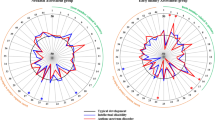Abstract.
In order to complement findings in the field of early autism and in the context of our studies on the quantitative neurobiological evaluation of patients with autism, we studied a large population of infants later diagnosed as having autistic disorder, using multivariate descriptive statistical methods. The population included 74 infants between six and 35 months, evaluated with the Infant Behavioural Summarised Evaluation (IBSE) scale. Thirteen of the 33 items of the IBSE scale were selected according to previous studies on older patients with autistic disorder. Correspondence analysis was applied to these 13 items, followed by a classical cluster analysis. This procedure permitted the identification of four different profiles which were distinguished on the basis of five main behaviours: activity, auditory perception, sensorimotility, eye contact and use of objects. These profiles are similar to those identified in older children with autism. This study provides an objective description of early clinical markers of the heterogeneity in autism and thus contributes to the description of the onset of autistic disorder. It identified more precise clinical subtyping which will be valuable for future bioclinical studies.
Similar content being viewed by others
Author information
Authors and Affiliations
Corresponding author
Rights and permissions
About this article
Cite this article
Malvy, J., Barthélémy, C., Damie, D. et al. Behaviour profiles in a population of infants later diagnosed as having autistic disorder. European Child & Adolescent Psychiatry 13, 115–122 (2004). https://doi.org/10.1007/s00787-004-0374-2
Accepted:
Issue Date:
DOI: https://doi.org/10.1007/s00787-004-0374-2




